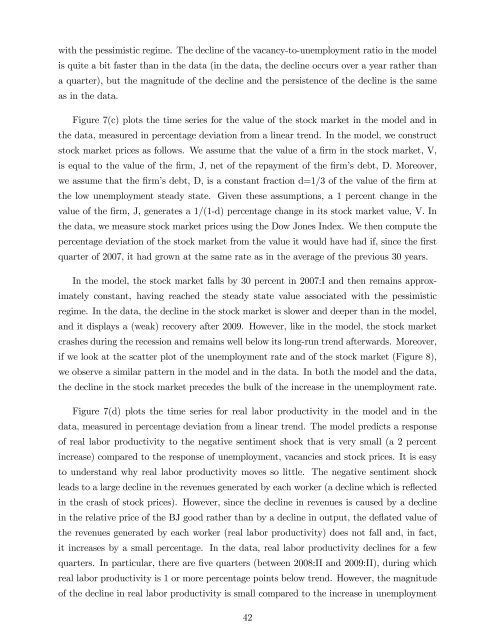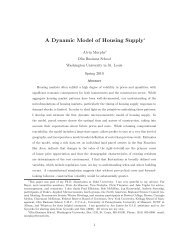Shopping Externalities and Self Fulfilling Unemployment Fluctuations*
Shopping Externalities and Self Fulfilling Unemployment Fluctuations*
Shopping Externalities and Self Fulfilling Unemployment Fluctuations*
Create successful ePaper yourself
Turn your PDF publications into a flip-book with our unique Google optimized e-Paper software.
with the pessimistic regime. The decline of the vacancy-to-unemployment ratio in the modelis quite a bit faster than in the data (in the data, the decline occurs over a year rather thana quarter), but the magnitude of the decline <strong>and</strong> the persistence of the decline is the sameas in the data.Figure 7(c) plots the time series for the value of the stock market in the model <strong>and</strong> inthe data, measured in percentage deviation from a linear trend. In the model, we constructstock market prices as follows. We assume that the value of a …rm in the stock market, V,is equal to the value of the …rm, J, net of the repayment of the …rm’s debt, D. Moreover,we assume that the …rm’s debt, D, is a constant fraction d=1/3 of the value of the …rm atthe low unemployment steady state. Given these assumptions, a 1 percent change in thevalue of the …rm, J, generates a 1/(1-d) percentage change in its stock market value, V. Inthe data, we measure stock market prices using the Dow Jones Index. We then compute thepercentage deviation of the stock market from the value it would have had if, since the …rstquarter of 2007, it had grown at the same rate as in the average of the previous 30 years.In the model, the stock market falls by 30 percent in 2007:I <strong>and</strong> then remains approximatelyconstant, having reached the steady state value associated with the pessimisticregime. In the data, the decline in the stock market is slower <strong>and</strong> deeper than in the model,<strong>and</strong> it displays a (weak) recovery after 2009. However, like in the model, the stock marketcrashes during the recession <strong>and</strong> remains well below its long-run trend afterwards. Moreover,if we look at the scatter plot of the unemployment rate <strong>and</strong> of the stock market (Figure 8),we observe a similar pattern in the model <strong>and</strong> in the data. In both the model <strong>and</strong> the data,the decline in the stock market precedes the bulk of the increase in the unemployment rate.Figure 7(d) plots the time series for real labor productivity in the model <strong>and</strong> in thedata, measured in percentage deviation from a linear trend. The model predicts a responseof real labor productivity to the negative sentiment shock that is very small (a 2 percentincrease) compared to the response of unemployment, vacancies <strong>and</strong> stock prices. It is easyto underst<strong>and</strong> why real labor productivity moves so little. The negative sentiment shockleads to a large decline in the revenues generated by each worker (a decline which is re‡ectedin the crash of stock prices). However, since the decline in revenues is caused by a declinein the relative price of the BJ good rather than by a decline in output, the de‡ated value ofthe revenues generated by each worker (real labor productivity) does not fall <strong>and</strong>, in fact,it increases by a small percentage. In the data, real labor productivity declines for a fewquarters. In particular, there are …ve quarters (between 2008:II <strong>and</strong> 2009:II), during whichreal labor productivity is 1 or more percentage points below trend. However, the magnitudeof the decline in real labor productivity is small compared to the increase in unemployment42
















